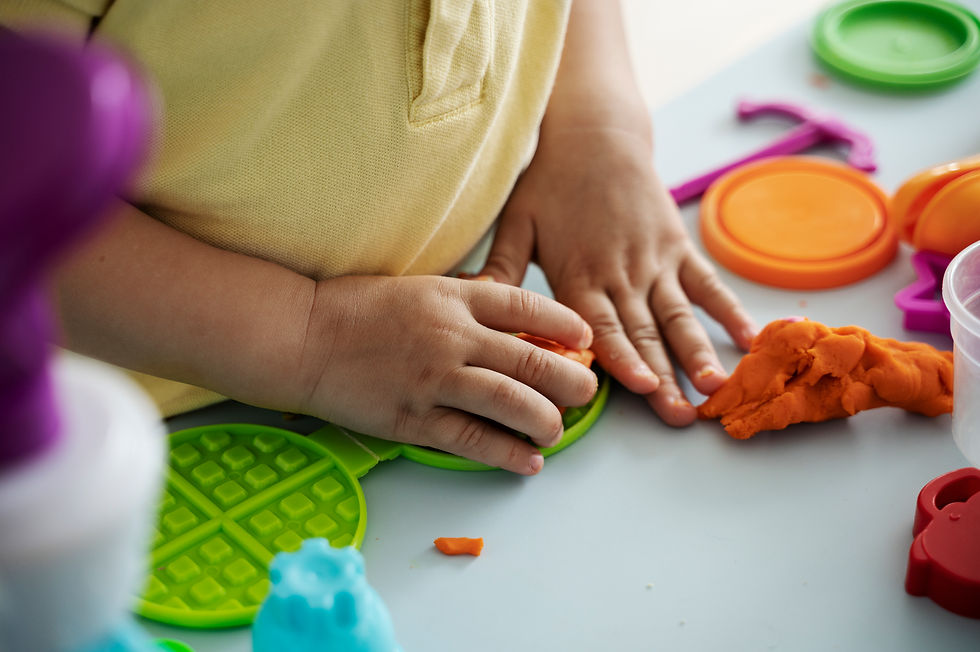Dealing With Toddlers Who Bite: A Simple Guide for Stressed Parents
- Kreepers and Krawlers

- Oct 9, 2023
- 3 min read

Navigating the treacherous waters of toddlerhood can often feel overwhelming, especially when your little one starts to bite. If your adorable child is suddenly sinking their teeth into siblings, playmates, or even you, rest assured you're not alone in this. Biting is a widespread yet misunderstood phase that many toddlers go through. As perplexing and stressful as it might be, it's crucial to recognize that your toddler isn't acting maliciously. They might resort to biting as a form of communication, driven by frustration, teething discomfort, or sheer curiosity. In this post, we'll explore the whys of biting and offer practical, straightforward strategies to manage and mitigate this challenging behavior. So, take a deep breath and explore solutions together to ensure this phase is just a fleeting hiccup in your child's development journey.

Why Do Toddlers Bite?
Biting is a typical toddler reaction when they can't express themselves through words. Understanding these triggers is the first step towards managing this behavior, whether it's because they're teething, feeling frustrated, or simply exploring their environment.
Easy-to-Follow Strategies:
Let's dive into some simple, actionable strategies to help you and your toddler navigate this biting phase smoothly.
1. The Knot-Biting Diversion:
Select a Bandana: Offer different colored bandanas for your toddler. The color selection process itself is empowering and engaging for them.
The Knot: Tying a knot and placing the bandana on their wrist provides a safe alternative to biting.
Dialogue: Engage your toddler in a daily conversation about using the bandana when they feel like biting. This routine fosters communication skills early on.
Parent Reflection: Have you incorporated similar tools before? Did it work for you?

2. Prevention & Gentle Redirection:
Prevent: If you see your toddler about to bite, gently intervene.
Comfort: If a bite occurs, comfort the victim immediately, showcasing empathy and care.
Gentle Reminder: Remind your toddler that biting hurts and isn't nice.
Parent Reflection: Do you have a specific way to comfort the bitten child and the biter? Share your comforting techniques!
3. Emotional Intelligence Boost:
Teaching toddlers to name and understand their emotions can significantly decrease biting incidents. When they can express themselves verbally, they won't feel the need to communicate through biting.
Parent Reflection: Can you recall when recognizing and addressing emotions helped prevent a biting incident?
Book Recommendations
Books are fantastic tools to help children understand complex emotions and actions. Here are some you might consider reading with your toddler:
"Teeth Are Not for Biting" by Elizabeth Verdick: "Teeth Are Not for Biting" is an engaging, durable book designed to guide young children through understanding the purpose of their teeth while discouraging biting others. The author, Elizabeth Verdick, illuminates various reasons why children might feel inclined to bite, offering them and their caregivers positive and constructive alternatives to handle different emotions and physical sensations.
"No Chomping, Baby Dino" by B Daugherty: "No Chomping, Baby Dino" is a delightful book that addresses toddlers’ playful biting behaviors through the story of Danny Dino, a playful dinosaur who must learn to use words instead of biting during excitement. This engaging narrative not only entertains toddlers but also educates them on alternative ways to express excitement, making it a valuable resource for parents navigating through their child's biting phase.
"Benjamin Monkey No Biting" by Big Red Balloon: Benjamin, a little monkey prone to biting, struggles to express his emotions verbally, leading to unfavorable consequences. To prevent losing his friends, Benjamin must learn to use words to articulate his feelings.
"I Count To Four. I Do Not Bite!" by Suzanne T. Christian: "I Count To Four. I Do Not Bite!" uses engaging characters and stories to teach toddlers impulse control and mindfulness. The book makes learning about self-control both accessible and enjoyable for young children.
Parent Reflection: Have any books worked wonders for you and your toddler? Share your recommendations!

Exploring Sensory Alternatives
Offer alternatives that satisfy your toddler's need to explore different textures without resorting to biting:
Varied-Textured Foods: Introduce foods with various textures.
Sensory Bags: These bags, filled with different materials like sand or gel, provide a fun and safe texture exploration experience.
Playdough and Putty: These materials are excellent for kids to explore and manipulate safely.
Parent Reflection: What are your child's favorite sensory exploration tools? Share your tips and tricks!
Navigating through your toddler's biting phase might be challenging, but remember, it's temporary. With understanding, consistent effort, and sharing experiences with other parents, you'll help your child move past this stage smoothly. What has your experience been like? Please share your stories, and let's support each other through this journey!








Comments